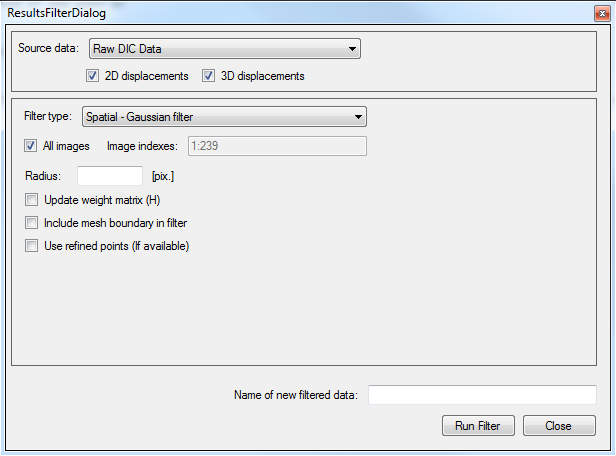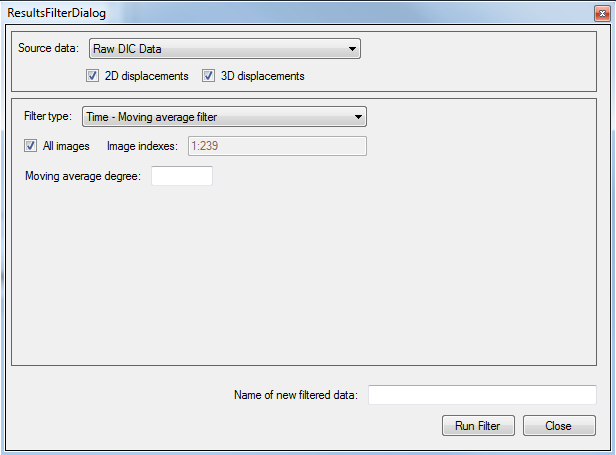Results Filter Dialog¶
There are basically two different types of filtering that can be done, i.e. Spatial - Gauss Weighting and Time - Moving Average. These will be explained below. The other types available in the dialog box must be seen as experimental.
Spatial - Gauss Weighting
The Gauss filter is a spatial filter, i.e. it acts on the nodal displacements for a particular time step (frame id) and smooths the displacements in the image plane.

- To define a filter, you must first specify the source. By default it is the Raw DIC Data, but it can also be any previosly filtered data.
- The filter type is now set as Spatial - Gaussian filter.
- You need to specify if the filter should act on all images defined in the DIC input file, or just a selection of images.
- The Spatial-Gauss filter needs a specified radius in pixels. (Default = 25 pixels)
- Before clicking the Run Filter-button, specify a name for the filtered data set.
The Gaussian filter acts on the nodal displacement in the DIC results, and the nodal displacement ![\bm{u}_i = [u_i, v_i]^T](../../../_images/math/7b6323b820d78a1af292894af365be3d3f288903.png) for a particular node
for a particular node  is given by a weighted sum of the nodal
displacements of all
is given by a weighted sum of the nodal
displacements of all  active nodes in the mesh:
active nodes in the mesh:

where the wheight  is given by a gaussian bell-curve:
is given by a gaussian bell-curve:

The specified radius  is provided by the user, and the constant
is provided by the user, and the constant  is chosen such that
is chosen such that 
A large radius  will give a wide bell curve (weighting curve) and thus, a high degree of smoothing, while a small radius will give a narrow bell curve and little smoothing of the nodal displacements.
will give a wide bell curve (weighting curve) and thus, a high degree of smoothing, while a small radius will give a narrow bell curve and little smoothing of the nodal displacements.
Time - Moving Average
The moving-average filter acts on each node separately and smooths its displacement in time.

- To define a filter, you must first specify the source. By default it is the Raw DIC Data, but it can also be any previosly filtered data.
- The filter type is now set as Time - Moving Average.
- You need to specify if the filter should act on all images defined in the DIC input file, or just a selection of images.
- Specify a moving average degree. This means how many time steps (frame id’s) should be used in calculating a specific average displacement.
A high degree means high degree of smoothing, while a small number means little smoothing of the nodal displacements in time.
- Before clicking the Run Filter-button, specify a name for the filtered data set.